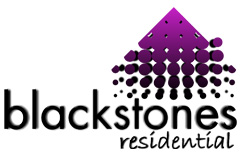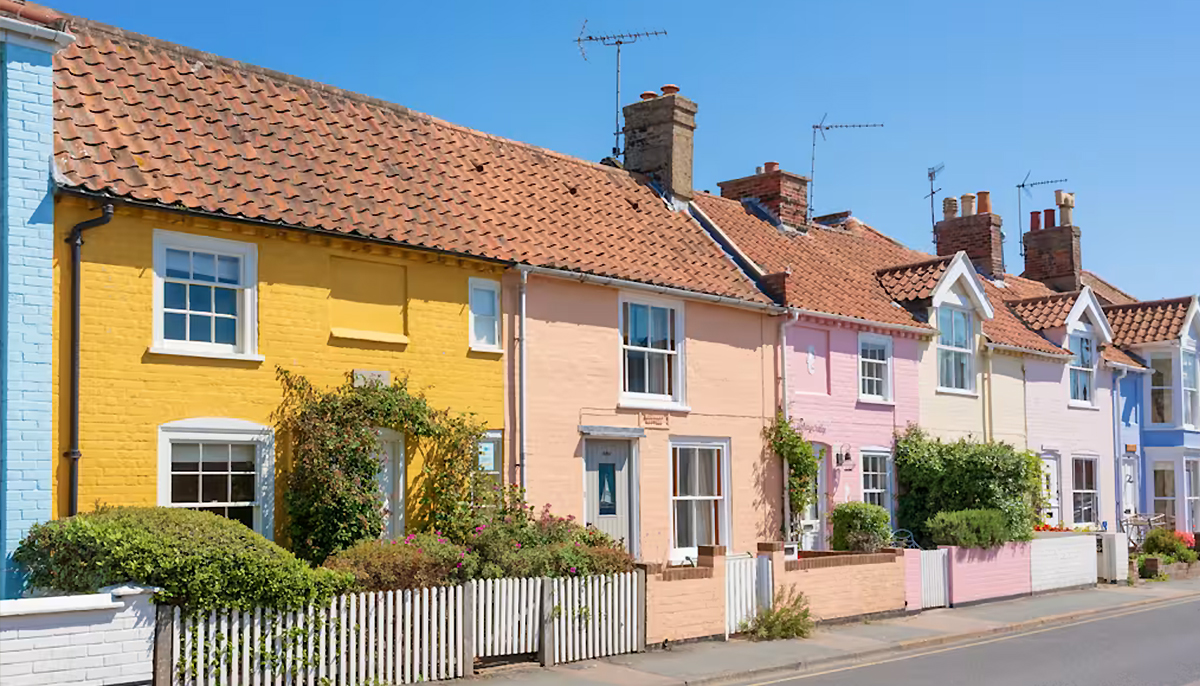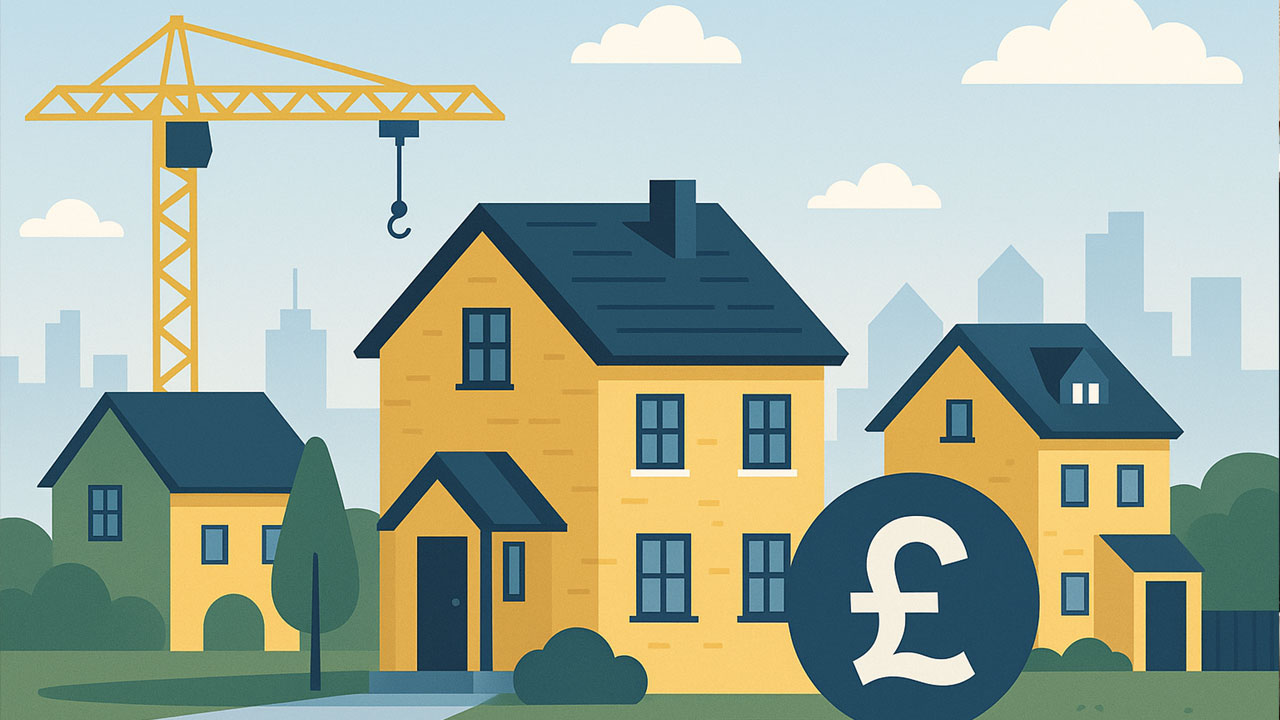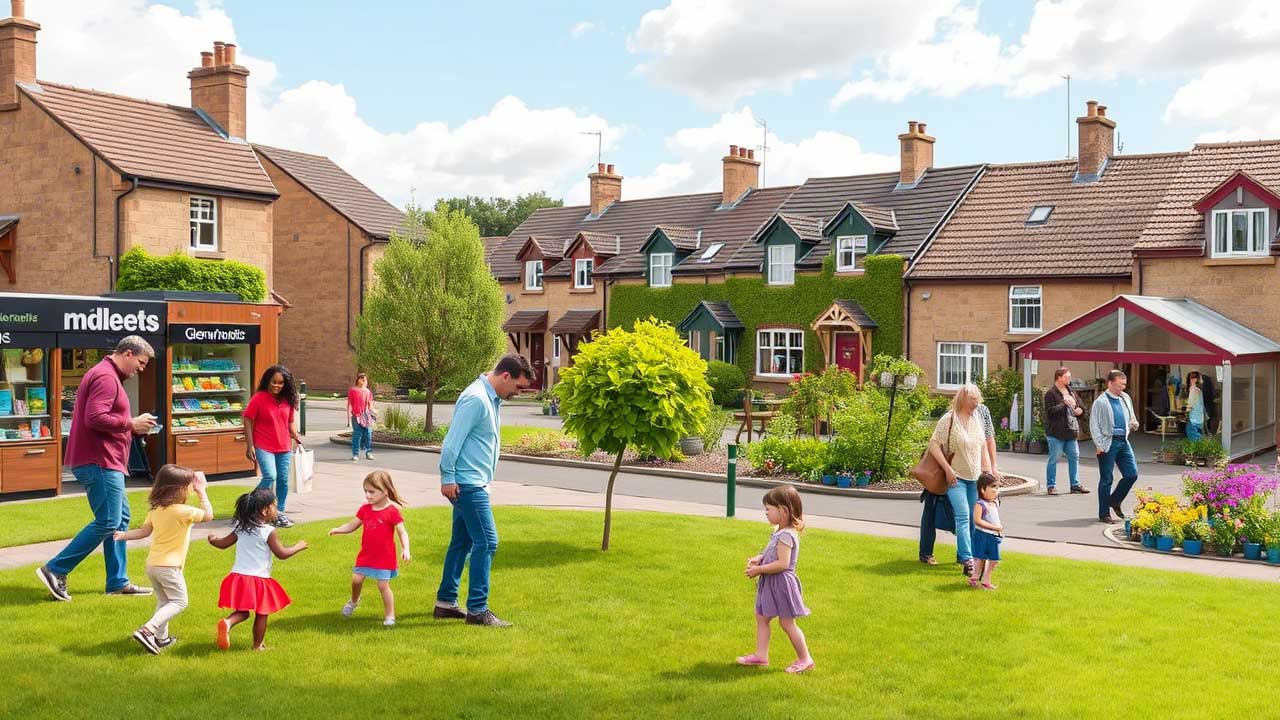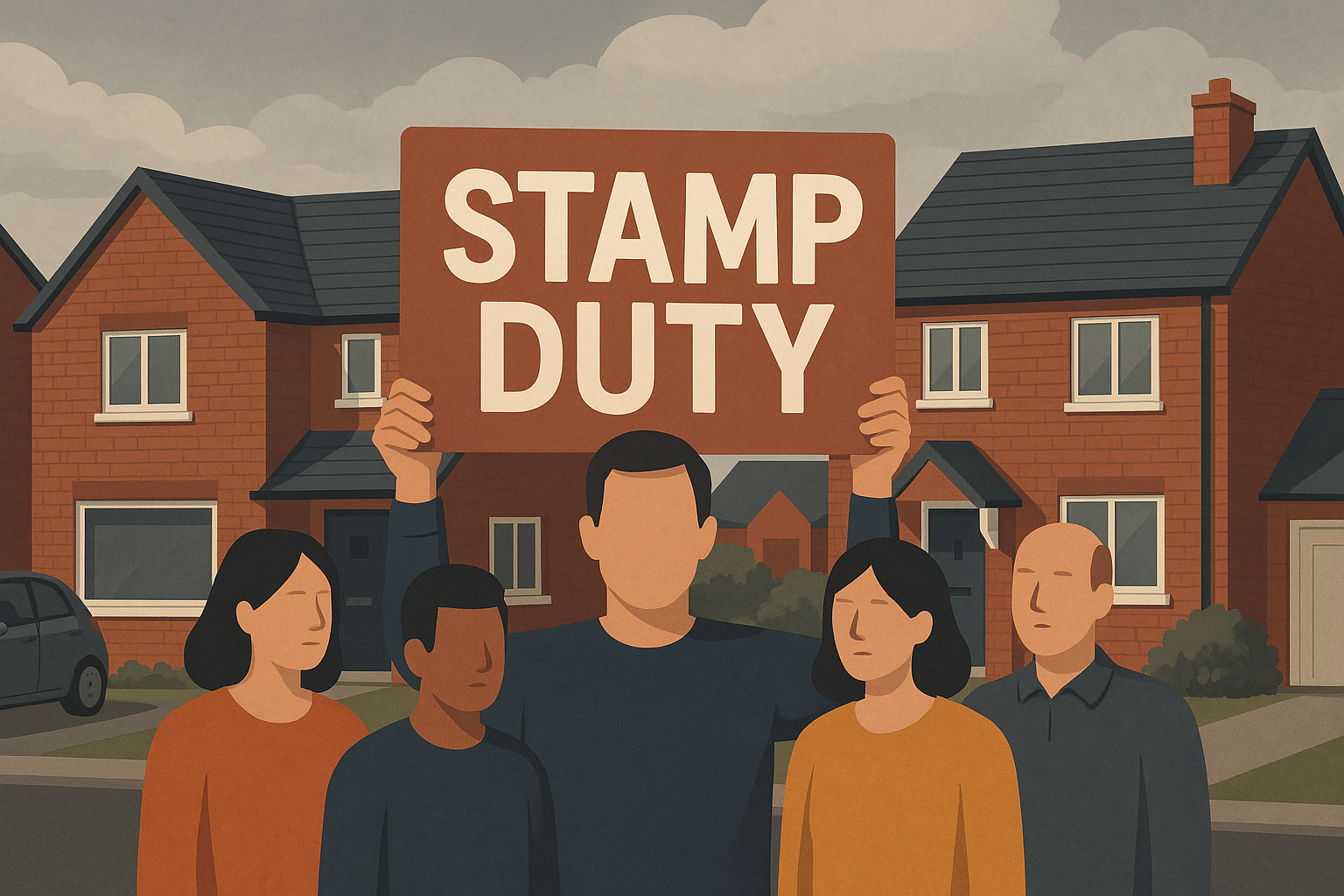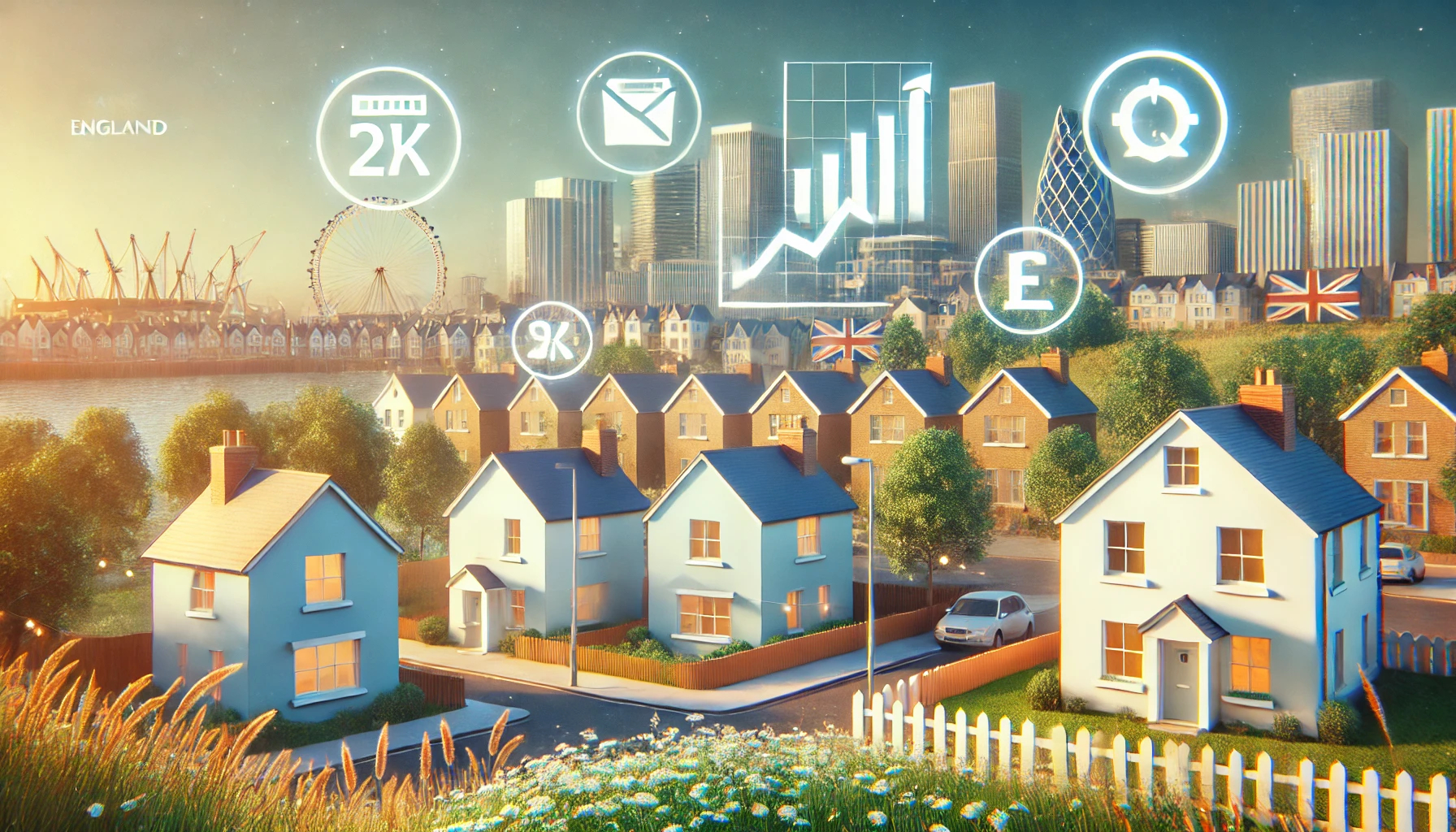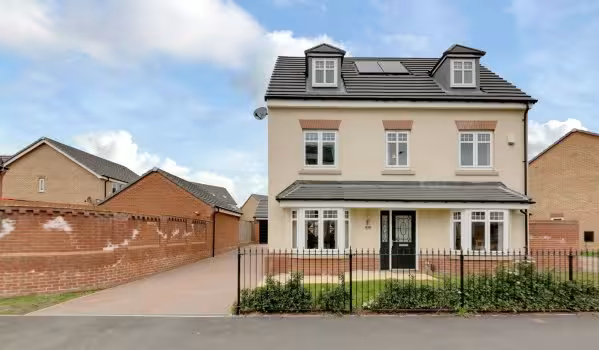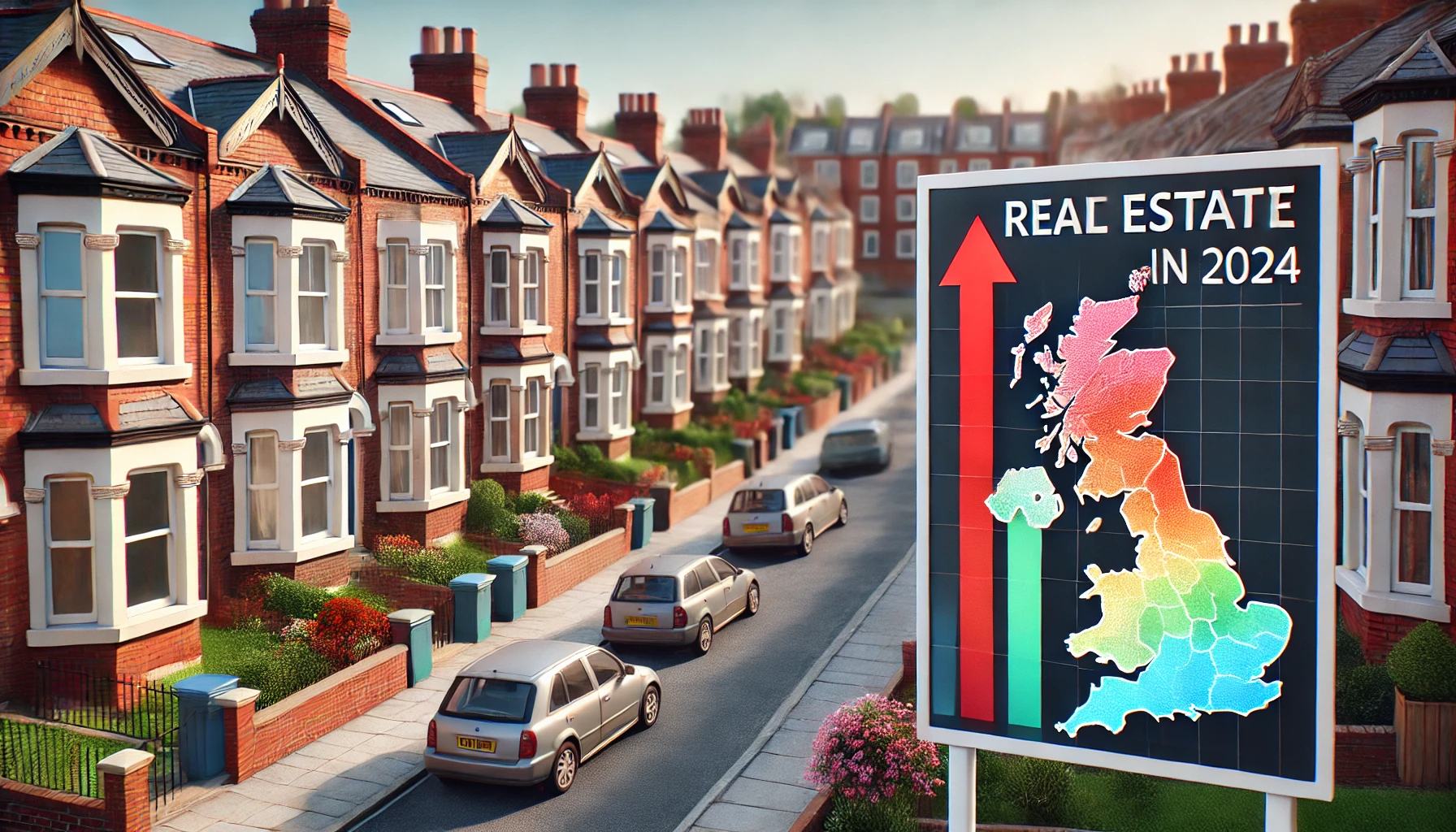Is Your Childhood Town Still Affordable? A Look at UK House Price Shifts
Two decades of rising house prices may be pricing Brits out of the places they once called home.
Ever dreamt of moving back to your childhood hometown, perhaps to walk the same streets, pop into the corner shop that sold your favourite sweets, or raise a family where you grew up?
You’re not alone. Over half of Brits (52%), say they’d consider returning to the area they grew up in. But for many, that heart-warming vision clashes with a hard-hitting reality: they simply can’t afford it anymore.
Our latest research reveals that average UK house prices have jumped by 74% over the past two decades, rising from £113,900 in 2005 to £268,200 in 2025. For millions, this growth has transformed childhood stomping grounds into financially unreachable dreamlands.
The South price surge: dreams delayed
Some of the steepest climbs in property prices have occurred in London, the South East and the East of England, where returning home now often comes with a hefty price tag.
Londoners have witnessed a jaw-dropping 119% rise in average house prices since 2005, now sitting at an average of £534,400. Meanwhile, Elmbridge in Surrey takes the title for the largest average house price increase in the South East, up 110% to a wallet-wincing £712,700.
Over in the East of England, St Albans leads the charge with house prices more than doubling from £289,600 to £622,100. That’s a 110% increase, largely driven by the region’s commuter convenience and historical charm. Not quite the budget-friendly return home many may have imagined.
However, like the South East, there are more affordable pockets in the East of England.The popular coastal town Great Yarmouth has seen the lowest growth in average house price increases in the region over the last 20 years, up 77% from £105.900 to £187,700.
|
Region |
Avg house price in 2025 |
Avg house price in 2005 |
Percentage increase |
|---|---|---|---|
|
London |
£534,400 |
£244,200 |
119% |
|
South East |
£385,400 |
£206,100 |
87% |
|
East of England |
£337,500 |
£180,600 |
87% |
|
South West |
£312,000 |
£179,300 |
74% |
|
East Midlands |
£231,000 |
£136,100 |
70% |
North-South divide: nostalgia comes cheaper up north
But it’s not all doom and skyrocketing property ladders. Those born and raised in Northern regions may be pleasantly surprised to find affordability still within reach.
The North East has seen the smallest increase in house prices, just 39% over twenty years. In Sunderland, homes have only nudged up by 22%, from £101,600 to £124,000. In Blackpool, the rise is similarly modest, up just 26%, with homes costing £124.300, up from £98,400 in 2005, making it one of the most affordable seaside towns for returnees.
Affordability has improved in real terms in the North West and Yorkshire, too, with house price to earnings ratios falling: From 6 to 5.1 in the North West and 5.7 to 5 in Yorkshire - a rare bit of good news in the housing market saga.
|
Region |
Avg house price in 2025 |
Avg house price in 2005 |
Percentage increase |
|---|---|---|---|
|
Wales |
£206,500 |
£125,600 |
64% |
|
North West |
£200,800 |
£126,300 |
59% |
|
Yorkshire and the Humber |
£190,400 |
£121,200 |
57% |
|
North East |
£146,400 |
£115,800 |
26% |
|
Scotland |
£168,000 |
£103,100 |
63% |
A tale of two towns
To paint the picture clearly: if you’re heading home to Elmbridge, expect to fork out over £370,000 more than in 2005. But a move to Hull, where prices have risen a more modest 49%, might only cost you around £38,000 more than it would’ve twenty years ago.
The local authority with the lowest increase in house prices is Sunderland, where prices have crept up by just £22,400 over the past two decades.
Planning your next move
Daniel Copley, consumer expert at Zoopla, sums it up: "Our latest analysis brings to light the profound impact two decades of house price growth has had on the dream of 'returning home'. UK house prices have soared by 74% since 2005, making that nostalgic return financially unattainable for many, especially in hotspots in the South East and the East of England."
"However, the picture is far from uniform across the UK. Our data shows that while some areas have seen dramatic increases, house prices have risen slowly, in line with incomes in northern regions. This means that for some, the dream of returning to their roots might be much more attainable than they think.”
Key takeaways
- 52% of Brits say they would consider a move back to the area where they grew up
- But it may not be that easy - house price rises across the UK are pricing people out of their hometowns
- House prices across the UK have increased by an average of 74% over the last 20 years, from £113,900 to £268,200
- South East and Eastern England have registered a significant jump in house prices, increasing by 87% in both regions, with Elmbridge in Surrey seeing the biggest increase in house prices, up from £338,800 to £712,700
- Affordability has improved significantly in northern regions, particularly in the North East where average house prices have increased by 39%, the smallest increase across the UK over the last 20 years
- In Blackpool, average house prices have increased by just 26%, with homes costing £124.300, up from £98,400 in 2005
Everything You Need to Know About Gen H’s New Build Boost – A New Alternative to Help to Buy
What Is New Build Boost?
New Build Boost is a home financing scheme introduced by Gen H designed to help people purchase new-build properties with a lower deposit. It combines a standard mortgage with an interest-free equity loan to lower upfront costs and improve affordability.
Key Features:
-
Buy with just a 5% deposit
-
Get a 15% interest-free equity loan from Gen H
-
Take out an 80% LTV mortgage
-
The equity loan remains interest-free for the full mortgage term
-
You own 100% of the property
For the first five years, the equity loan is locked at its original value. After that, repayments adjust with the market value of the home but are capped at twice the original loan amount.
Who Can Apply?
The scheme is open to:
-
First-time buyers and existing homeowners
-
Buyers purchasing a new-build home from Persimmon or Charles Church
-
Those with a deposit of 5–15% (from savings or a gift)
📍 Not available in Scotland or Wales
How Does It Compare to Help to Buy?
While inspired by the Help to Buy model, New Build Boost introduces several differences:
| Feature | Help to Buy | New Build Boost |
|---|---|---|
| Buyer eligibility | First-time buyers only | Includes homeowners |
| Interest-free period | 5 years | Entire mortgage term |
| Loan-to-value | 75% mortgage + 20% loan + 5% deposit | 80% mortgage + 15% loan + 5% deposit |
| Equity loan value adjustment | Based on market value from year 6 | Fixed for 5 years, then adjusts (capped) |
| Application process | Separate mortgage and loan steps | Integrated application through Gen H |
In short, New Build Boost offers greater long-term predictability and simpler access, even for those who’ve owned before.
Why It Matters
With the end of Help to Buy, many buyers were left without viable support. Gen H’s New Build Boost could provide a lifeline for those struggling with deposits or affordability—especially in today’s challenging housing market.
Is It the Right Choice for You?
While schemes like this can open doors to homeownership, they aren’t for everyone. Monthly repayments may be higher than a standard mortgage, and if your new build is leasehold, you’ll need to budget for service charges or ground rent.
✅ Speak to a mortgage broker or financial advisor to evaluate whether this fits your budget and long-term goals.
Next Steps
If you’re interested in buying a new-build home and are worried about saving a large deposit, consider exploring New Build Boost.
📞 Talk to a mortgage adviser
🌐 Visit Gen H’s official site for more information
Key takeaways
- Bigger Borrowing Power: Gen H is offering the potential to borrow more, with borrowers being assessed against 80% Loan to Value (LTV) criteria. For some eligible borrowers, they might be able to borrow up to 5.5 times their income. And what's better, buyers will own the entire home from day one.
- Potentially Smaller Deposits: New Build Boost unlocks 80% LTV mortgages on new-build homes with just a 5% deposit. It aims to help first-time buyers, and those looking to buy a new build, get on the ladder with less savings required.
- Thinking Outside the Box: Gen H aren't your typical mortgage lender, and this new product seems to reflect that. They're talking about how they can be more flexible and "reimagine the new build buying journey."
What to Expect for Mortgage Rates in 2025
Rates are projected to hold steady between 4% and 5%, while relaxed lending criteria may improve affordability for homebuyers.
Following the recent base rate reduction—from 4.5% to 4.25% in May 2025—analysts anticipate that mortgage rates will remain relatively stable, hovering between 4% and 5% throughout the remainder of the year.
Since reaching a high in mid-2023, mortgage costs have steadily eased. Back in June 2023, the average rate for a five-year fixed mortgage at 75% loan-to-value climbed to 5.8%, significantly increasing monthly repayments for many borrowers.
Now, that same loan product has seen a notable decline, with the average rate down to approximately 5.04%, offering some relief to prospective buyers and existing homeowners alike.
Average mortgage rates in May 2025
|
Deal length and type |
Current average rate across all lenders |
Current average rate across 'big six' lenders |
|---|---|---|
|
2 year fixed-rate (75% LTV) |
4.79% |
4.27% |
|
5 year fixed-rate (75% LTV) |
5.04% |
4.19% |
|
2 year variable rate (75% LTV) |
4.75% |
4.7% |
|
Standard variable rate (SVR) |
7.74% |
6.75% |
All average rates are provided by Mojo Mortgages. The above are the average mortgage rates for various products across the market. These won't necessarily be available to you, and are not the only product types available.
Most forecasters are expecting mortgage rates to remain in the 4-5% range this year, even if inflation and the base rate edge lower.
Our Executive Director of Research, Richard Donnell, says: ‘Expectations of lower interest rates are already priced into fixed rate mortgages today.
‘Lower interest rates would likely result in further modest declines in mortgage rates but how far depends on how low money markets see base rates falling.
‘Economists currently expect base rates to fall to 3.5% by the end of 2025, which would imply mortgage rates remaining in and around the 4%+ range.’
Why are mortgage rates going down?
Mortgage rates began to go down in the latter half of 2023, as inflation dropped from 6.3% in September to 4.2% in December.
In June 2024, inflation hit its 2% target, but it has risen slightly since then and is currently sitting at 2.6%.
The Bank of England cut the base rate twice last year, first in August and again in November - and then again in February 2025.
At the most recent Bank of England meeting in May 2025, the Bank dropped the base rate to 4.25%. Some forecasters are predicting it will fall further by the end of the year.
The bank rate determines the interest rate the Bank of England pays to commercial banks that hold money with them. It influences the rates those banks charge people to borrow money or pay on their savings.
What factors affect interest rates?
Inflation is the main reason interest rates have been high in the UK over the last 3 years. An unexpected rise in demand - or decrease in supply - can cause inflation to rise.
At the end of 2021, the Bank of England began to raise the base rate in order to reduce inflation and help slow down price rises for everyday items including food, petrol, gas and electricity.
Inflation is currently hovering over its 2% target at 2.6%, so the Bank of England needs to keep the base rate high enough to ensure inflation doesn't rise again.
Global shocks can also have an impact on inflation, such as wars, pandemics and tariffs as they affect the flow of goods around the world.
Easing Affordability Tests Could Strengthen Buyer Confidence in 2025
A shift in how lenders assess mortgage applications may soon improve access to home financing. One significant change on the horizon is the easing of affordability checks, which could help boost borrowing power and reinvigorate housing market activity this year.
Although borrowers typically focus on their actual mortgage rate—currently averaging around 4.5% for a 5-year fixed term—lenders also assess whether they could afford repayments at a much higher hypothetical “stress” rate. At present, many lenders use stress rates of 8–9%, making it harder for buyers with smaller deposits to qualify.
If lenders return to pre-2022 stress levels of 6.5–7%, buyers could see their borrowing capacity increase by up to 20%. For example, a first-time buyer currently needing to show they can cover £1,550 in monthly payments at an 8.5% stress rate would only need to demonstrate affordability at £1,275 under a 6.5% rate—freeing up their budget and increasing buying options. While the exact impact varies by lender and borrower type, the effect would likely support housing demand and sales.
However, it's important to note that other mortgage regulations and criteria will continue to influence access to credit.
Housing Market Sees More Listings—and More Buyer Choice
As of early 2025, the number of homes on the market is up 12% compared to last year. With more sellers entering the market—many of whom are also planning to buy—there's greater choice for prospective buyers.
This increased inventory may limit upward pressure on prices. “We believe the wider availability of homes will help keep house price growth moderate,” explains Donnell. Buyers may find more room to negotiate, especially on properties that aren’t drawing much interest.
Affordable Regions Lead the Way in Sales Growth
Despite cost pressures from higher mortgage rates, demand remains strong in lower-priced areas. Recent data shows that regions with more accessible housing continue to outperform others.
“Sales volumes are climbing across the UK, but we’re seeing the most robust growth in places with more affordable homes,” says Donnell. Wales, the North West, and the North East are currently leading the way, each with a 10–14% annual increase in sales activity.
These trends highlight the resilience of the market and point to a potential shift in buyer behavior as affordability remains a key driver in 2025.
Key takeaways
- Mortgage rates are expected to hold steady around 4-5% throughout 2025
- A two-year variable rate with a 75% loan-to-value ratio currently averages 4.75% while the average five-year fixed term sits at 5.04%
- The base rate dropped to 4.25% in May 2025 in positive news for households
- Changes to affordability testing by mortgage lenders could make it easier for buyers to borrow
- The Base Rate could fall further by the end of 2025
Top 10 Budget-Friendly Towns Families Are Flocking To
Explore the trending towns where affordability meets family-friendly living—these spots are gaining serious attention.
Our experts have uncovered the most popular affordable towns for families, crowning Glenrothes in East-Central Scotland number one across the whole of the UK.
In Glenrothes, in the heart of Fife and just an hour from Edinburgh, you can expect to pay an average of £136,900 for a three-bed home – that’s £540 in monthly mortgage payments.
We examined the most affordable towns and then worked out which areas were getting the most interest from property-searchers on Zoopla.
We also calculated an income-to-affordability to ratio to help you work out if one of these places would meet your budget.
Most popular affordable towns for families by region
We looked at the most popular affordable towns by region, discovering that there are affordable places for families to live even in the most expensive UK regions.
Sutton-in-Ashfield in the East Midlands takes the top spot by region, with a three-bed home expected to cost £189,400 or £750 in monthly mortgage payments.
Barking and Dagenham is the most popular affordable area in London. For a three-bed home you’ll pay £1,750 in monthly mortgage payments, based on an average value of £440,300.
Bootle is the most popular affordable town in the North West, with three-bed homes valued at half the national average at £142,900.
Plymouth offers the best affordability for families in the South West of England, with three-bed homes averaging £261,000, or £1,040 per month in mortgage payments.
Here are the best places to live in each region of the UK for families, based on the average price of a three-bed home and the popularity of homes for sale there.
|
Town |
Region |
Avg 3-bed £ |
Estimated earnings* |
Monthly mortgage £** |
Price to earnings ratio*** |
|---|---|---|---|---|---|
|
Sutton-in Ashfield |
East Midlands |
£189,400 |
£67,100 |
£750 |
2.8 |
|
Tilbury |
East of England |
£347,800 |
£84,900 |
£1,380 |
4.1 |
|
Bedlington |
North East |
£154,800 |
£75,100 |
£610 |
2.1 |
|
Bootle |
North West |
£142,900 |
£76,400 |
£570 |
1.9 |
|
Glenrothes |
Scotland |
£136,900 |
£78,200 |
£540 |
1.8 |
|
Dartford |
South East |
£423,600 |
£90,800 |
£1,680 |
4.7 |
|
Plymouth |
South West |
£261,000 |
£70,100 |
£1,040 |
3.7 |
|
Llanelli |
Wales |
£170,600 |
£75,800 |
£680 |
2.3 |
|
Willenhall |
West Midlands |
£225,100 |
£68,100 |
£890 |
3.3 |
|
Dewsbury |
Yorks&Humber |
£192,000 |
£71,300 |
£760 |
2.7 |
|
Barking & Dagenham |
London |
£440,300 |
£79,400 |
£1,750 |
5.5 |
10 most popular affordable towns for families in the UK
We've also identified the top 10 towns for families to live across the whole of the UK by looking at the most affordable places along with how many people are searching for homes there.
|
Rank |
Town |
Region |
Avg 3-bed £ |
Estimated earnings* |
Monthly mortgage £** |
Price to earnings ratio*** |
|---|---|---|---|---|---|---|
|
1 |
Scotland |
£136,900 |
£78,200 |
£540 |
1.8 |
|
|
2 |
Wales |
£170,600 |
£75,800 |
£680 |
2.3 |
|
|
3 |
Wales |
£176,400 |
£74,800 |
£700 |
2.4 |
|
|
4 |
Wales |
£160,300 |
£74,800 |
£640 |
2.1 |
|
|
5 |
Scotland |
£168,600 |
£80,500 |
£670 |
2.1 |
|
|
6 |
Wales |
£142,200 |
£71,400 |
£560 |
2.0 |
|
|
7 |
South East |
£423,600 |
£90,800 |
£1,680 |
4.7 |
|
|
8 |
Scotland |
£164,600 |
£78,200 |
£650 |
2.1 |
|
|
9 |
Scotland |
£177,600 |
£82,300 |
£700 |
2.2 |
|
|
10 |
South East |
£444,900 |
£95,100 |
£1,770 |
4.7 |
(Source: Zoopla research 2025; *Two full-time earners/ **Estimated earnings required/***Q1 2025)
You’d need an estimated household income of £72,200 to afford a three-bed home in Glenrothes.
We discovered that it’s possible to buy a three-bed home for well under the national UK average house price of £268,000 in all but two of the towns on our list.
Four out of 10 of the most popular towns are in Scotland, including Wishaw (£168,600; £670 a month), Leven (£164,600; £650 a month) and Larkhall (£177,600; £700 a month).
Welsh towns take the second, third and fourth spots in our UK-wide list, with Llanelli (£170,600 on average; £680 monthly mortgage), followed by Neath ( £176,400; £700 a month) and Port Talbot (£160,300; £640 monthly).
Two places in the South East make an appearance - the Kent towns of Dartford and Swanley, whose relative affordability compared to other parts of the region make them popular places for families to live.
Perhaps unsurprisingly though, they are the priciest of the affordable towns on our list of family-friendly hotspots.
Families looking for a three-bed home in Dartford will need to pay an average of £1,680 in monthly mortgage payments, based on an average value of £423,600.
While anyone wanting a three-bed home in Swanley will need to pay £444,900 or £1,770 in monthly mortgage payments on average.
Affordability ‘remains critical’ for families
“This latest analysis paints a clear picture of a market where affordability remains a critical factor for families planning their next home move,” said Richard Donnell, Executive Director at Zoopla.
“What's particularly telling is the level of buyer interest these towns are attracting; three-bedroom homes in the most popular affordable locations are seeing twice the amount of listing views compared to the regional average,” he adds.
“This heightened popularity, coupled with the significant portion of would-be buyers expressing concerns about being priced out of housing, underscores the ongoing challenges facing movers and the clear appetite for value.”
How we crunched the numbers
To hit upon our top 10 of affordable places for families to live, we looked at the most affordable areas nationally and then looked at the popularity of listings of three-bed homes in those areas.
We found that property listing views were twice as high for three-bed homes in the most popular affordable towns compared to the regional average for similar properties.
In order to work out affordability, we measured the ratio of average three-bed house prices in an area to average earnings in the local area.
In each region, 30% of towns with the lowest price-to-earnings ratios were selected, resulting in a final list of 248 towns, plus 10 London boroughs (used in place of postal towns for the capital).
Popularity was ranked based on the average listing views for a three-bed home in each area.
To estimate monthly mortgage repayments for a typical three-bed house in the town, we calculated the cost of a 20% deposit, a 30 year repayment period, with a mortgage rate of 4.3%
A third of buyers fear being priced out
Meanwhile, separate research reveals that a third of buyers are worried they can’t afford to buy in their ideal family home location.
According to a survey of 2,000 UK adults conducted in April, 34 per cent of buyers fear being priced out of their preferred area.
Of those surveyed, 37 per cent said they would be happy to move to an entirely new region in the UK in order to buy a more affordable family home.
The average monthly mortgage payment for a £304,600 three-bed home is currently £1,210. Those surveyed, however, said they felt £870 was a reasonable mortgage payment.
Two in five respondents said they were unwilling to move from their ideal location.
Those willing to move said they would only be willing to move an average of 41 minutes away.
Key takeaways
- We've identified the top towns for families to live in every region of the UK
- We looked at the most affordable places to buy a three-bed home along with how many people are searching for homes there
- Sutton-in-Ashfield in the East Midlands takes the top spot by region, while Barking and Dagenham wins for London, Bootle takes the crown in the North West and Plymouth tops the list in the South West
- We crowned Glenrothes in Scotland the most popular town for families seeking affordability across the whole of the UK
- A three-bedroom home in Glenrothes is listed at £136,900 on average – around half the national average house price of £268,000
- We calculated affordability based on a regional price-to-earnings ratio so you can find out how much you need to earn to buy a three-bed home there
- Separate research shows a third of buyers are anxious about being priced out
Base rate lowered to 4.25% by the Bank of England
The Bank of England has lowered its key interest rate to 4.25%. This is how the change could affect borrowing costs and the housing loan sector and what it could mean if you're planning to relocate or buy a new home.
Ahead of today’s meeting of the Bank of England’s Monetary Policy Committee (MPC), experts were divided on whether another base rate cut was likely — some anticipated a pause in rate adjustments, while others expected a more aggressive move.
However, it has now been confirmed that the Bank of England has reduced the base rate by 0.25 percentage points, lowering it to 4.25% — the lowest it's been in two years.
The decision was not unanimous, with the MPC voting 5-2-2. Two members pushed for an even larger rate cut, and two favoured holding rates steady.
The base rate — sometimes referred to as the 'bank rate' or simply the 'interest rate' — plays a crucial role in determining the cost of borrowing across the economy, including mortgage rates offered by lenders.
The Bank has been using the base rate as a way of taming inflation, which hit a recent peak of 11.1% in October 2022.
The Bank increased the base rate from 0.1% in late 2021, to 5.25% in August 2023. It then cut the rate twice last year, first in August, again in November and then again in February this year.
The good news is that inflation has recently dropped. The Consumer Prices Index (CPI), a key measure of inflation, stood at 2.6% in the year to March. While that’s still above the Bank’s 2% target, it’s edged down from 2.8% in the year to February.
In its Monetary Policy Report today, the Bank said that inflation is “following a bumpy path”.
It explained: “Inflation will increase temporarily this year before falling back to the 2% target. This is partly because of increases in energy prices, and increases in some regulated prices such as water bills.
"Inflation could stay higher than expected if the prices of some services continue to rise quite quickly. On the other hand, demand in the economy could be weaker than expected, which would lower prices."
How does this impact interest rate predictions for 2025?
The report took a positive yet cautious approach to future base rate changes, stating "If things evolve as expected, we expect to reduce interest rates further."
"We will judge carefully how far and how fast to cut interest rates. The best contribution we can make to support economic growth and people’s prosperity is to make sure we have low and stable inflation."
What does the base rate cut mean for mortgage rates?
If you’re planning to get a new mortgage soon, you’re likely to see the lower base rate factored into new deals. This could make moving more affordable for you.
Whether you’re moving, buying your first home or your fixed rate is ending, it’s worth seeing if any lower rates are now available to you.
Key takeaways
- The Bank of England has cut the base rate from 4.5% to 4.25%, its lowest level in around 2 years
- The decision is likely to improve mortgage affordability, paving the way for more people to move house this year
- The base rate, also known as the 'bank rate’ or the ‘interest rate’, influences the rates that mortgage lenders charge their borrowers
- Today’s decision comes after UK inflation dropped by more than expected to 2.6% in March.
Four in five homeowners in England and Northern Ireland to pay more stamp duty from 1st April
Four in five existing homeowners (83%) will pay stamp duty from April, up from 49% today as the 2% band returns between £125k and £250k, adding up to £2,500 per purchase
Analysis from Zoopla, one of the UK’s leading property websites, has revealed that the cost of buying a home will increase for the majority of home buyers in England and Northern Ireland from April, when the stamp duty land tax (SDLT) relief introduced in the 2022 mini budget ends and reverts to previous rates.
The impact and extra cost will vary across the country and between existing homeowners and first-time buyers as different rates apply. Overall Zoopla estimates that these changes will raise an extra £1.1bn a year in stamp duty for the government.
| Buyer type | Percentage of sales paying stamp duty today | Percentage of sales paying stamp duty from April 2025 | Extra sales caught by stamp duty from April 2025 | Stamp duty free sales from April 2025 |
|---|---|---|---|---|
| First-time buyer | 21% | 42% | +21% | 58% |
| Homeowner | 49% | 83% | +34% | 17% |
Majority of homeowners to pay more stamp duty
From the 1st April of 2025, four in every five (83%) homeowners will pay stamp duty on buying a main residence, up from 49% today, as the two percent rate between £125,000 and £250,000 returns. Less than a fifth of homeowners (17%) will pay no stamp duty on purchases below £125,000.
This means that the 49% of homeowner purchases over £250,000 will pay an extra £2,500 in stamp duty from April. The 33% of buyers purchasing between £125,000 and £250,000 will pay two percent on the purchase price up to a maximum of £2,500. Zoopla estimates this will generate an additional £900m in stamp duty.
The biggest jump in buyers paying stamp duty will be in the West Midlands where 66% more sales will pay from April, followed by 55% in the East Midlands and 50% in the North West.
The proportion of first-time buyers paying stamp duty doubles
First-time buyers will pay stamp duty on purchases over £300,000 from April, meaning three in five (58%) will avoid this extra cost of buying. This helps those buying in areas with lower house prices. The number of first-time buyers liable to pay stamp duty will be the lowest in the North East (two percent), Yorkshire and the Humber (three percent), Northern Ireland (five percent) and the North West (five percent).
However, the proportion of first-time buyers liable to pay stamp duty will double to 42% from April, hitting London and South East buyers in the £300,000 and £625,000 range the hardest, with costs of up to £15,000 per purchase. Buying at £350,000 will cost £2,500 per purchase, up from £0 today. Buying a £500,000 home will cost £10,000 in stamp duty, up from £3,750 today and buying at £550,000 will jump from £6,250 to £15,000.
Zoopla estimates this will generate an additional £200m in stamp duty.
Richard Donnell, Executive Director at Zoopla comments
Existing homeowners will pay up to £2,500 more for each purchase across a large number of sales. The average seller has made £60,000 in capital gains so there is flexibility to absorb this cost but buyers will expect to factor this extra cost into what they offer.
It’s positive that most first-time buyers will still pay no stamp duty from April, but these changes hit those buying over £300,000 in southern England the most where buying costs are already high. This will reduce buying power and market activity at a local level.
Stamp duty is a big tax on home movers in southern England where affordability problems are already a major challenge. The case for reforming stamp duty remains but the question is where to replace the multi billion in annual tax revenues.
Key takeaways
- Four in five existing homeowners (83%) will pay stamp duty from April, up from 49% today as the 2% band returns between £125k and £250k, adding up to £2,500 per purchase
- Less than a fifth of existing homeowners (17%) will pay no stamp duty
- The biggest jump in home buyers paying stamp duty will be in the West Midlands where 66% more sales will pay stamp duty from April
- The proportion of first-time buyers liable to pay stamp duty will double to 42% from April, hitting those buying in London and the South East the hardest
- However, 58% of first-time buyer purchases will still pay no stamp duty under property purchases of £300,000 with buyers in the north benefitting the most
- Overall these changes are estimated to raise an extra £1.1bn a year in stamp duty for the government
Good News for Borrowers? Base Rate Cut to 4.5% Explained
How the 4.5% base rate could shape the property market and your mortgage.
The Bank of England has cut the base rate by 0.25% and it now stands at 4.5%.
The Bank's Monetary Policy Committee (MPC) voted by a majority of 7–2 to reduce the base rate by 0.25%, to 4.5%. Two members preferred to cut the rate by 0.5%, to 4.25%.
The MPC last met in December, when it voted by 6-3 to hold the base rate at 4.75%.
The base rate, also known as the 'bank rate' or the 'interest rate', is important because it influences the rates that lenders charge their borrowers for things like mortgages.
Why has the base rate been cut?
The Bank has been using the base rate as a way of taming inflation, which hit a recent peak of 11.1% in October 2022.
The Bank increased the base rate from 0.1% in late 2021, to 5.25% in August 2023. It then cut the rate twice last year, first in August and then again in November.
The good news is that inflation has recently dropped. The Consumer Prices Index (CPI), a key measure of inflation, stood at 2.5% in the year to December. While that’s still above the Bank’s 2% target, it’s edged down from 2.6% in the year to November. It’s the first decline in three months.
In its Monetary Policy Report today, the Bank said that inflation is “following a bumpy path”.
It explained: “We expect inflation to rise temporarily this year, to 3.7%, including because of higher energy prices. Inflation is expected to fall back again to the 2% target after that.
“We need to be confident that inflation will remain low and stable in a lasting way. The Monetary Policy Committee will decide carefully by how much and when it can cut interest rates.”
The report also warned that the economy “may not evolve as expected, including because there could be global shocks. For example, global trade tariffs or developments in the Middle East could impact some prices”.
Andrew Bailey, the Bank’s governor, took a cautious tone when the MPC held the base rate in December: “We think a gradual approach to future interest rate cuts remains right, but with the heightened uncertainty in the economy we can’t commit to when or by how much we will cut rates in the coming year,” he said at the time
What does the base rate cut mean for mortgage rates?
Borrowers with mortgages that track the base rate are set to see an almost immediate impact on their mortgage rates. Meanwhile borrowers on fixed-rate deals that expire soon are likely to see the lower base rate factored into new deals.
Richard Donnell, Executive Director of Zoopla, said: “Today’s cut to the base rate will provide a boost to market sentiment for home buyers, more than a boost to buying power.
“The path of base rates is already priced into fixed-rate mortgages, which account for the majority of new mortgages.
“It’s positive that 2025 is starting with lower mortgage rates than the last two years. The average five-year fixed rate at 75% LTV is 4.4% while a two-year fix is at 4.6% (according to Bank of England data).”
Hina Bhudia, partner, Knight Frank Finance, reacting to the Bank's Money & Credit data on 30 January, said that mortgage rates have been largely steady during the early weeks of the year - though a handful of lenders did reprice a little higher during recent bond market volatility.
“That volatility has since eased and we do expect lenders to cut mortgage rates as soon as they are able to do so. They have fresh lending targets at the beginning of the year and are eager to build market share,” explained Bhudia.
“If the Bank of England does opt to cut the base rate as many as five times this year, as Morgan Stanley analysts predicted this week, borrowers shouldn't be waiting long for a reprieve.”
In the past week, Barclays, Coventry Building Society, Yorkshire Building Society, Santander, TSB and Co-op have all cut mortgage rates, according to The Sun.
How could this impact the housing market more broadly?
Our latest House Price Index shows that the 2025 sales market has started off better than both 2024 and 2023. This bodes well for market activity throughout the rest of the year.
And today’s base rate decision has the potential to boost confidence and improve affordability, paving the way for more moves across the housing market.
“Greater stability in borrowing costs has brought more buyers and sellers back into the housing market having delayed moving decisions as rates spiked higher. The latest Zoopla data (to Sunday 4th February) shows a healthy supply of homes for sale and home buyer demand 9% higher than a year ago, with 11% more sales agreed,” explained Donnell.
“We expect average mortgage rates to remain in the 4-5% range over the year ahead. Lower base rates will support the wider economy which in turn, will support housing market activity where we expect 5% more housing sales over the year to 1.15m and average house price growth of 2.5%.”
Donnell added that the average mortgage rate for all outstanding mortgages has risen and now stands at 3.8% as borrowers refinance mortgages.
“The last of the ultra-low rate five-year fixes taken in 2021 will be refinancing in the next 18 months as the whole housing market sees mortgage rates resetting to current levels,” Donnell said.
Key takeaways
- The Bank of England has cut the base rate by 0.25%. It now stands at 4.5%
- The Bank's Monetary Policy Committee (MPC) voted by a majority of 7–2 to reduce the base rate by 0.25%, to 4.5%.
- The base rate, also known as the 'bank rate’ or the ‘interest rate’, influences the rates that lenders charge their borrowers
- Today’s decision comes after UK inflation fell to 2.5% in December. It was the first drop in the rate of inflation for three months
Smart Ways to Afford a New-Build Home
Did you know buying a new-build home can be more budget-friendly than an older property?
If you’re looking to move this year, you may have started to weigh up whether to buy a new-build home or an older property. There are many contributing factors to this decision, but a big one is affordability. And when it comes down to it, new builds win by a long way.
So let’s take a deeper look at this. What makes new builds the affordable option? And how can you make the most of your budget when buying a new home?
Buying schemes for first-time buyers and home movers
One of the biggest perks of new-build homes is the number of schemes and incentives available to buyers. For both first-time buyers and home movers, these initiatives can make all the difference when it comes to saving cash.
Some schemes you can take advantage of are:
-
Deposit Unlock: Buy a new home with a 5% deposit and dramatically reduce your upfront costs. This scheme is available to first-time buyers and home movers.
-
Own New - Rate Reducer: An initiative that can give you access to lower mortgage rates. It’s a regular mortgage that uses a developer incentive to lower monthly payments for the initial period. (This period depends on how much you earn and which lender you are matched with.) Rate Reducer enables you to access mortgage rates below 2.88%*, which could mean a potential saving of up to £304 on monthly repayments**. This scheme is available to first-time buyers and home movers.
-
Shared Ownership: Purchase a percentage of the property (typically between 25% and 75%) and pay rent on the remainder, making homeownership achievable on a smaller budget. This scheme is only available to first-time buyers.
-
Deposit contributions: Some developers will top up your deposit to help reduce the upfront cost of buying your home. This added support not only accelerates your home-buying journey but can also make you eligible for more competitive mortgage rates by increasing your deposit size. This is available to first-time buyers and home movers
-
Part exchange: If you own a home already, many house builders offer part exchange. This is where the developer purchases your existing property directly, allowing you to focus on securing your new home. With part exchange, the developer covers the cost of estate agent fees and acts as a guaranteed buyer for your current property, saving you the hassle of selling on the open market.
-
Assisted moving schemes: Through schemes like Easy Move, developers work with local estate agents to market and manage the sale of your existing home—and they’ll cover the costs.
Aside from Shared Ownership, these schemes are exclusive to new-build homes.
To find out about which buying schemes are available at developments near you, check the description of the property or development on Zoopla, contact the developer directly, or seek advice from a specialist new-build broker.
Green mortgages and utility bill savings
New homes are built to increasingly higher standards and regulations to ensure improved energy performance and reduced water usage. This means that as well as benefitting from new technology and building practices, you’ll also get a few financial perks.
Green mortgages reward you for living in an energy-efficient home. If the property you're buying or living in has an EPC rating of A or B, you'll get cashback or a better interest rate on your mortgage. With 86% of new builds earning an A or B EPC rating, new homes are very likely to qualify.
Speak to a mortgage broker for more details on green mortgages and whether you could get a better rate.
The improved energy efficiency of today’s new-build homes also means you could save £979 a year on your heating, hot water and lighting costs on average.** That’s a potential saving of £82 a month.
Another sustainable benefit of new homes that’s often overlooked is the built-in water efficiency. The average new build homeowner uses 40 litres less (per person per day) than owners of older properties. Less water used = a cheaper water bill!
With savings to both your water and energy bills, a new home can really help to lower your monthly outgoings.
Fewer unexpected financial surprises
With a new-build home, everything is brand new—from the boiler to the roof. This means you’re far less likely to face unexpected repairs or replacements. And any defects you do come across will be covered by the developer’s multi-year warranties.
With the time you and effort you save avoiding renovation work, you can focus on settling in and making it your own from day one.
Compare that to an older property, where you could quickly find yourself budgeting for a new boiler or kitchen renovation when you uncover its horrible hidden history. Research has even shown it could cost more than £70k to bring an old home up to the modern standards found in new-build homes.
Over time, these savings add up. While an older home might seem cheaper at first glance, the ongoing costs of maintenance, renovation work and running costs can make it more expensive in the long run.
Why buy new?
While every buyer’s situation is different, there are a number of reasons new homes can actually be a more affordable option than purchasing an existing property. With financial incentives, lower running costs, and no unexpected repairs to pay out for, they can save you money upfront and in the long term. Add in the peace of mind that comes with warranties and guarantees, it’s clear why so many buyers are turning to the new build market.
*Example assumes a 3% homebuilder incentive and is based on mortgage rates available in the market, with a 2 year initial period and an LTV of 75%. Savings made in the initial fixed period only and mortgage repayments may increase thereafter. Independent financial advice must be sought from a regulated mortgage broker to access this scheme. This example should be used as a guide only and does not represent the suitability, eligibility or availability of mortgage offers for users. For exact figures, users will need to approach an official mortgage lender. Your home may be repossessed if you do not keep up your mortgage repayments. Rates valid as of 14-01-2025
**Example based on market interest rates, with an average house price of £360,000 and an average mortgage term of 35 years. Assumes a 3% homebuilder incentive and a 2 year fix, with 75% LTV mortgage. Independent financial advice must be sought from a regulated mortgage broker to access this scheme. This example should be used as a guide only and does not represent the suitability, eligibility or availability of mortgage offers for users. For exact figures, users will need to approach an official mortgage lender. Your home may be repossessed if you do not keep up your mortgage repayments. Rates valid as of 14-01-2025
Key takeaways
- You can access buying schemes with new builds to save you money and help you buy
- You can get a green mortgage and save on utility bills by living in an energy-efficient new build
- You don’t have to worry about maintenance costs with a new build
Why new-build homes offer so much more : Building better
A deep dive into why new homes are built to a much higher standard compared to older homes.
There’s no doubt that when it comes to buying a home, the structure of the property and its build quality can come out at the top of people’s considerations.
For some, a quality build means an older property. But with ever-evolving modern techniques, standards and innovations in construction, the build quality of brand new homes can come out as far superior to those built decades or centuries ago.
From improved sustainability to designs focused on modern-day living, new homes are testament to how much the home-building industry has improved to meet the needs of today’s buyers. Let’s take a deeper look.
Modern techniques
Older homes were often built with features that fall short of modern standards. But today, new homes have traded in single-pane windows and poor insulation for double or triple glazing and energy efficient heat-trapping materials.
Modern Methods of Construction (MMC) incorporate off-site manufacturing techniques, where components such as walls, floors or entire units are manufactured in a factory and then transported to the site for assembly. MMC aims to reduce construction time, increase sustainability and ensure higher consistency in quality compared to traditional construction methods.
Consumer protections
Significant strides have also been made in consumer protections for new-build homes. With initiatives like the New Homes Quality Board (NHQB) and the New Homes Ombudsman Service (NHOS), buyers now enjoy unprecedented support and transparency during the buying process. Builders are required to meet strict quality standards, and the consumer codes in place mean that they must deal with any issue raised by a customer quickly and fairly. If they don’t, the customer has the right to access an independent ombudsman service. This setup is currently voluntary but now covers the majority of new homes sold each year. It ensures that buyers can make informed decisions with confidence, knowing they’re protected every step of the way.
Customer satisfaction
Customer satisfaction levels for new-build homes are at an all-time high. According to the latest National New Homes Customer Satisfaction Survey, over 90% of new home buyers say they’d recommend their builder to a friend. This reflects the efforts made by the house-building industry to improve quality and service.
Recommendations from the Competition and Markets Authority (CMA) are also increasing transparency and raising the bar for quality across the sector.
Energy efficiency
Modern homes also deliver on efficiency where older properties often fall short. New-build homes are incredibly energy efficient, emitting 65% less carbon than older properties—just 1.22 tonnes annually compared to 3.51 tonnes for older homes. With 86% of new builds earning an A or B EPC rating, compared to under 5% of older homes, they offer significant savings on energy bills. The average energy and water costs for new-build houses is 50% cheaper, resulting in a potential saving of £979 a year.
Sustainability
The focus on quality and sustainability is particularly important as the demand for housing grows. The CMA’s recent house-building market study highlighted the persistent challenges posed by the planning system, which has long hindered the delivery of new homes. While planning reform remains a pressing issue, the housing industry continues to adapt and innovate despite these obstacles. Builders have proven resilient, meeting the evolving needs of buyers while navigating a complex regulatory landscape.
Ultimately, today’s homes are more efficient, and more consumer-friendly than ever before. Modern construction techniques ensure that homes are built to last, while advancements in materials and technology enhance their performance and sustainability.
Key takeaways
- New homes are built with modern techniques and more energy efficient materials than older homes
- Consumer protections are in place meaning builders are required to meet strict quality and transparency standards
- Over 90% of new home buyers say they’d recommend their builder to a friend
- The average energy and water costs for new-build houses is 50% cheaper than older homes, resulting in a potential saving of £979 a year
UK house prices rebound in 2024, with half of all homes experiencing a £7,600 increase
The average UK home has appreciated by £2,400 in the last six months. However, this figure may not accurately reflect the substantial gains experienced by terraced properties in the northern regions.
Half of the UK’s 30 million homes increased in value in 2024.
House prices returned to growth following price falls in 2023, due to weakened buyer demand as a result of higher borrowing costs.
15 million homes increased in value by one per cent or more last year, up 42 per cent from the 10.6 million homes that increased in value over 2023.
The average increase in value for homes posting price gains was £7,600, with 6.9 million homes recording a price increase of £10,000 or more.
While 2024 saw a broad recovery of house prices, a third (9.2 million homes) still recorded a price decline of one per cent or more.
However, this is less than the number of homes that saw a decline in 2023: 12.8 million.
Just under six million homes saw broadly static prices over the year changing by +/- one per cent.
Half of homes in Great Britain increased in value in 2024

Home value gains lower in Southern England
A clear north-south divide remains when it comes to the fortunes of homeowners in 2024, with fewer homes in southern England recording an increase compared to the rest of Britain.
This reflects the underlying affordability of homes: higher mortgage rates affect buying power and house prices more in areas where home values are above average.
Just a third (36 per cent) of homes increased in value by one per cent or more across southern England. And two-fifths (41 per cent) of homes fell in value by an average of £8,700.
This is in sharp contrast to the northern regions of England and Scotland, where 63 per cent of homes registered value gains over 2024.
Coastal towns in Kent and East Sussex were least likely to register price gains in 2024. Many saw less than ten per cent of homes increase in value, while more than three-quarters of homes registered small price falls.
This is due to the fading of the pandemic boom and the subsequent search for additional space as more workers return to the office.
An additional factor is the increase in second homeowners selling in the face of a doubling in council tax from April, which is impacting pricing across many coastal towns.
Average value change by region
|
Region/ Country |
Avg. value change over 2024 |
% of homes with value increase of 1% or more |
No. of homes with value increase of 1% or more |
% of homes with value decrease of 1% or more |
No. of homes with value decrease of 1% or more |
|
North West |
£4,400 |
63% |
2,090,000 |
21% |
710,000 |
|
North East |
£4,300 |
68% |
820,000 |
19% |
230,000 |
|
West Midlands |
£3,900 |
59% |
1,480,000 |
22% |
560,000 |
|
Yorkshire & Humberside |
£3,700 |
61% |
1,500,000 |
23% |
570,000 |
|
Scotland |
£3,200 |
61% |
1,580,000 |
24% |
640,000 |
|
Wales |
£2,300 |
52% |
760,000 |
29% |
420,000 |
|
East Midlands |
£1,700 |
48% |
1,010,000 |
31% |
660,000 |
|
London |
£600 |
40% |
1,510,000 |
37% |
1,430,000 |
|
South West |
-£300 |
37% |
970,000 |
40% |
1,040,000 |
|
South East |
-£900 |
35% |
1,390,000 |
41% |
1,620,000 |
|
East of England |
-£1,300 |
33% |
880,000 |
43% |
1,150,000 |
Lower mortgage rates and rising incomes over 2024 have started to repair housing affordability.
More homes in Southern England increase in value over 2024 compared to 2023, from 2.8 million in 2023 to 4.8 million in 2024.
Areas in Wiltshire, Gloucestershire and Oxfordshire saw half of all homes register price gains over 2024. Additionally, Berkhamsted in Hertfordshire saw the largest national average annual price increase at £24,500.
House value increases most common in Northern England
Housing is more affordable outside of Southern England, where house prices are lower in comparison to incomes.
Lower house prices create more headroom for values to increase, despite higher borrowing costs. And more than three in five homes increased in value over 2024 across Northern England and Scotland
The North East is one of the most affordable regions and, as a result, seven in ten homeowners (820,000) in the region saw the value of their home increase by an average of £4,300.
One in five (270,000) homeowners saw house price growth of £10,000 or more.
Peterlee in County Durham saw the highest proportion of properties registering higher home values, with 83 per cent registering an increase by an average of £6,100.
The North West saw 63 per cent of homes increasing in value by one per cent or more, averaging £4,400, the highest average gain across all regions and countries of Great Britain.
The Cheshire area registered the largest value gains, with six in ten homes in Congleton and Knutsford increasing in value by £10,000 or more.
In Scotland and Yorkshire and the Humber, six in ten homes also gained value in 2024, with average increases of up to £19,300 (Biggar in Scotland), and £15,700 (Ripon in Yorkshire and the Humber).
Towns with the highest percentage of homes increasing in value in 2024
|
Region/ Country |
Town |
% homes with value increase of 1%+ |
No. of homes going up in value |
Avg. value change (£) |
|
East Midlands |
Glossop |
67% |
10,700 |
£7,000 |
|
East of England |
Berkhamsted |
53% |
5,900 |
£24,500 |
|
London |
Waltham Forest |
64% |
74,800 |
£8,700 |
|
North East |
Peterlee |
83% |
14,500 |
£6,100 |
|
North West |
Blackburn |
77% |
48,700 |
£8,100 |
|
Scotland |
Carluke |
82% |
7,800 |
£8,900 |
|
South East |
Thame |
56% |
4,100 |
£5,600 |
|
South West |
Portland |
54% |
3,700 |
£2,900 |
|
Wales |
Ferndale |
74% |
4,500 |
£3,900 |
|
West Midlands |
Wednesbury |
79% |
16,600 |
£6,000 |
|
Yorkshire and Humber |
Normanton |
81% |
8,700 |
£7,500 |
Towns with the highest percentage of homes decreasing in value in 2024
|
Region/ Country |
Town |
% homes with value decrease of 1%+ |
No. of homes falling in value |
Avg. value change (£) |
|
East Midlands |
Corby |
74% |
24,700 |
-£6,000 |
|
East of England |
Bungay |
79% |
4,400 |
-£8,400 |
|
London |
Kensington and Chelsea |
72% |
73,200 |
-£44,300 |
|
North East |
Houghton Le Spring |
48% |
13,100 |
£3,800 |
|
North West |
Cheadle |
54% |
14,100 |
-£2,000 |
|
Scotland |
Inverurie |
65% |
11,100 |
-£4,200 |
|
South East |
Broadstairs |
89% |
11,800 |
-£15,300 |
|
South West |
Ferndown |
83% |
11,500 |
-£14,400 |
|
Wales |
Pwllheli |
64% |
6,800 |
-£3,650 |
|
West Midlands |
Evesham |
45% |
10,000 |
£900 |
|
Yorkshire and Humber |
Beverley |
57% |
12,800 |
-£5,100 |
Our Executive Director Richard Donnell says: "The housing market returned to growth in 2024 but the pattern of home value changes across Britain is far from uniform. There is headroom for prices to increase in markets where housing is affordable compared to incomes, which covers many parts of northern England and Scotland.
"In contrast, affordability is more of a constraint on price rises in Southern England where the market continues to adjust to higher borrowing costs. Faster income growth is helping to repair affordability-supporting moving decisions in 2025.
“Every home has its own trajectory for price changes and millions of owners are tracking the value of their home on Zoopla as part of the decision of when to move home. The momentum from 2024 is spilling into 2025 with a seven-year high in the number of homes for sale.
"We expect more people to move home in 2025 than in 2024 despite uncertainty over the economic outlook and broadly static mortgage rates."
Key takeaways
- 15 million homes (that's half the UK's housing stock) gained £7,600 in value over 2024
- A third registered small value falls, mostly across Southern England, as higher mortgage rates reduced buying power
- The overall average price change for all 30m homes was a £2,400 increase
- Home values have been slower to recover in Southern England, with just over a third (36 per cent) of homeowners seeing home value gains in 2024
- Nearly two-thirds (62 per cent) of homes across Northern regions of England and Scotland saw home values increase
- Seven in ten homes gained value in the North East, but the average value increase over the year was highest in the North West at £4,400
